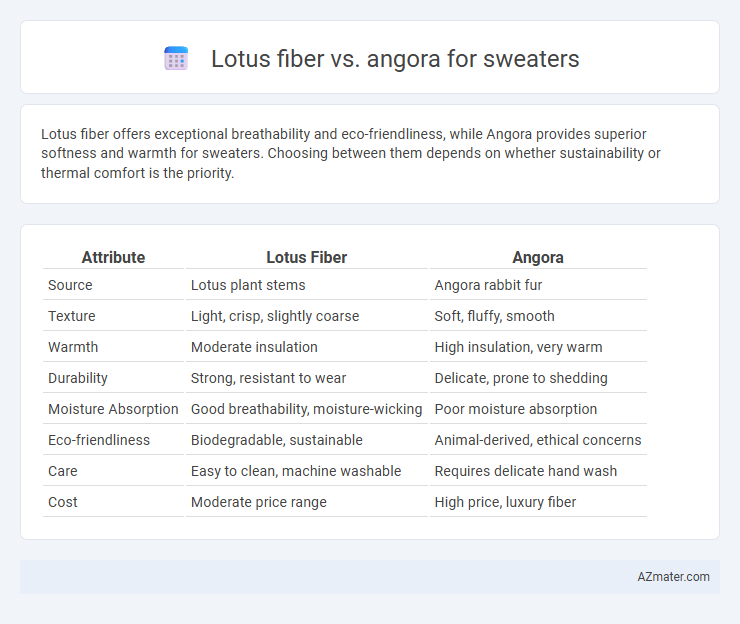Lotus fiber offers exceptional breathability and eco-friendliness, while Angora provides superior softness and warmth for sweaters. Choosing between them depends on whether sustainability or thermal comfort is the priority.
Table of Comparison
| Attribute | Lotus Fiber | Angora |
|---|---|---|
| Source | Lotus plant stems | Angora rabbit fur |
| Texture | Light, crisp, slightly coarse | Soft, fluffy, smooth |
| Warmth | Moderate insulation | High insulation, very warm |
| Durability | Strong, resistant to wear | Delicate, prone to shedding |
| Moisture Absorption | Good breathability, moisture-wicking | Poor moisture absorption |
| Eco-friendliness | Biodegradable, sustainable | Animal-derived, ethical concerns |
| Care | Easy to clean, machine washable | Requires delicate hand wash |
| Cost | Moderate price range | High price, luxury fiber |
Introduction to Lotus Fiber and Angora Wool
Lotus fiber, derived from the stems of lotus plants, offers a sustainable and eco-friendly alternative for sweaters with its lightweight, breathable, and biodegradable properties. Angora wool, sourced from Angora rabbits, is highly prized for its exceptional softness, warmth, and luxurious texture, often used in high-end knitwear. Both materials provide unique benefits in sweater production, with lotus fiber excelling in environmental sustainability while Angora wool delivers superior insulation and comfort.
Origin and Production Processes
Lotus fiber, derived from the stalks of the lotus plant primarily in Southeast Asia, involves a labor-intensive process where fibers are extracted manually, dried, and spun into yarn, resulting in a sustainable and biodegradable textile. Angora wool, sourced from Angora rabbits mainly in China and parts of Europe, is obtained by careful combing or shearing to collect soft, fluffy fibers, which are then spun into fine yarn known for its warmth and lightweight properties. Both fibers emphasize artisanal production methods but differ significantly in their plant-based versus animal-derived origins and ecological impacts.
Fiber Characteristics and Structure
Lotus fiber offers exceptional breathability and natural moisture-wicking properties due to its hollow, tubular structure, making it lightweight and comfortable for sweaters. Angora fiber is renowned for its superior softness and warmth, thanks to its fine, smooth, and fluffy hair derived from Angora rabbits. The structural difference, with lotus fibers being more rigid and longer while angora fibers are finer and more elastic, significantly impacts the texture and thermal insulation of sweaters made from each material.
Softness and Comfort Comparison
Lotus fiber offers a lightweight and breathable texture, promoting moisture-wicking and natural hypoallergenic properties, which enhances overall comfort in sweaters. Angora wool is renowned for its exceptional softness and insulating warmth, creating a plush and cozy wearing experience ideal for cold climates. While Angora excels in softness and thermal insulation, Lotus fiber provides superior breathability and eco-friendly benefits, making the choice dependent on desired comfort and environmental preferences.
Warmth and Insulation Properties
Lotus fiber offers moderate warmth and breathability, making it suitable for lightweight sweaters but less effective in extreme cold compared to Angora. Angora excels in insulation due to its fine, hollow fibers that trap air, providing superior warmth and softness in sweaters. When prioritizing thermal insulation, Angora is the optimal choice for maintaining body heat in colder climates.
Breathability and Moisture Management
Lotus fiber offers superior breathability and moisture-wicking properties compared to Angora, making it ideal for sweaters worn in warm or humid conditions. Its natural hollow structure allows for enhanced air circulation, which helps regulate body temperature and keeps the skin dry. In contrast, Angora sweaters provide warmth but tend to retain moisture, potentially causing discomfort in active or warm environments.
Durability and Longevity
Lotus fiber offers exceptional durability due to its naturally strong and coarse fibers, making it highly resistant to wear and tear in sweaters. Angora, while prized for its softness and warmth, tends to be more delicate and prone to fiber shedding and pilling, reducing its longevity. For long-lasting sweaters, lotus fiber provides superior resilience compared to the more fragile angora wool.
Environmental Impact and Sustainability
Lotus fiber and Angora wool differ significantly in environmental impact and sustainability, as Lotus fiber is derived from the lotus plant's stem, requiring minimal water and no pesticides, making it highly eco-friendly and biodegradable. Angora wool, harvested from Angora rabbits, often raises ethical concerns due to animal welfare issues and can have a higher environmental footprint because of intensive farming practices and resource use. Consumers seeking sustainable sweaters should prefer Lotus fiber for its renewable plant-based origin and lower ecological impact compared to Angora.
Price and Market Availability
Lotus fiber sweaters generally carry a higher price tag due to the labor-intensive extraction and limited production, positioning them in the niche luxury market. Angora sweaters are more widely available and offer a more affordable range, supported by established farming and processing industries, particularly in Europe and China. Market availability for angora is robust with numerous brands offering diverse styles, while lotus fiber remains rare and exclusive, appealing to eco-conscious consumers seeking unique, sustainable textiles.
Which Fiber is Best for Sweaters?
Lotus fiber offers exceptional breathability and natural moisture-wicking properties, making it ideal for lightweight, eco-friendly sweaters perfect for warm climates. Angora fiber, known for its superior softness and insulating warmth, creates plush sweaters that excel in cold weather comfort. Choosing between lotus fiber and angora depends on the desired sweater characteristics: durability and cool comfort versus softness and thermal insulation.

Infographic: Lotus fiber vs Angora for Sweater
 azmater.com
azmater.com